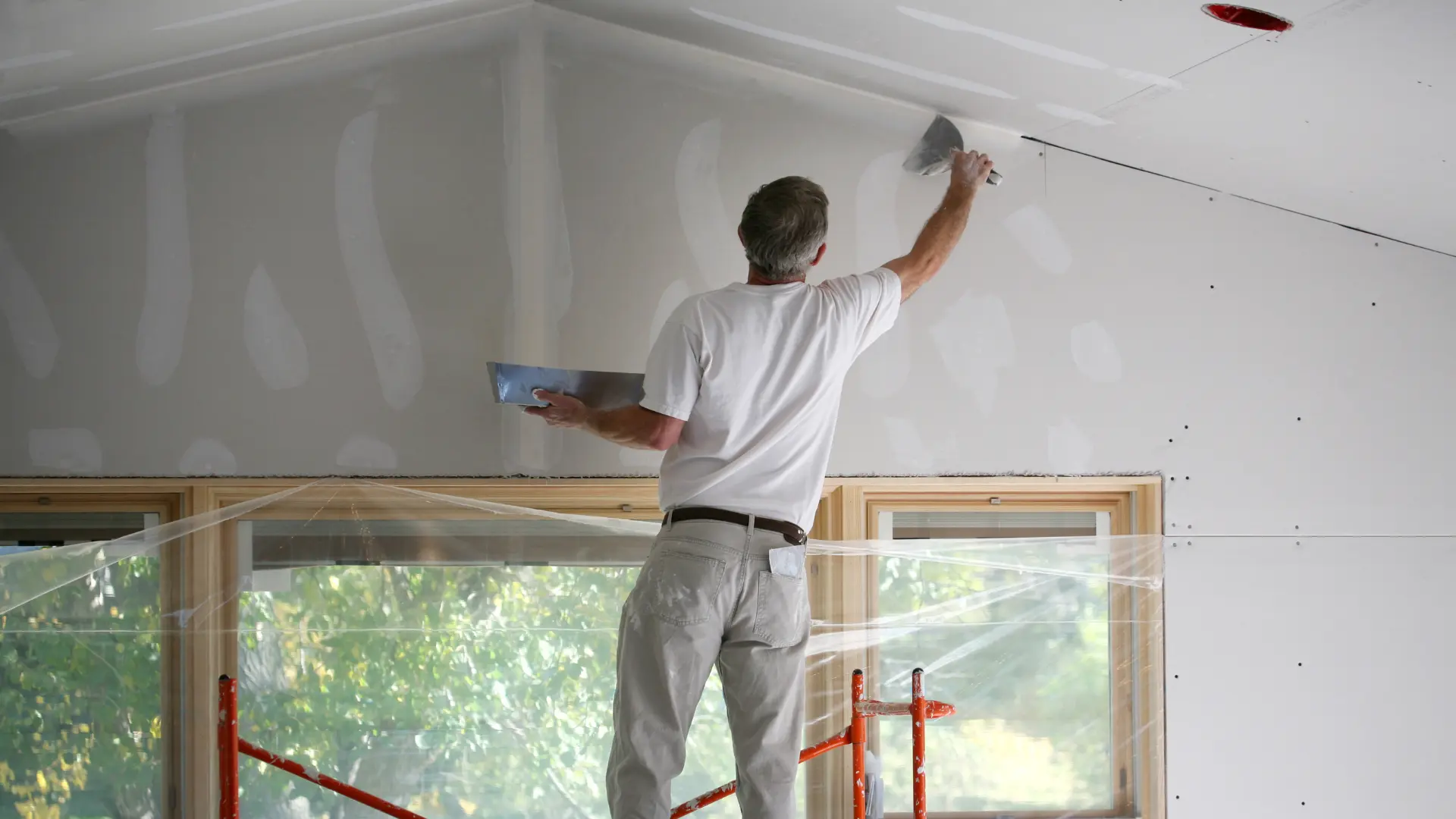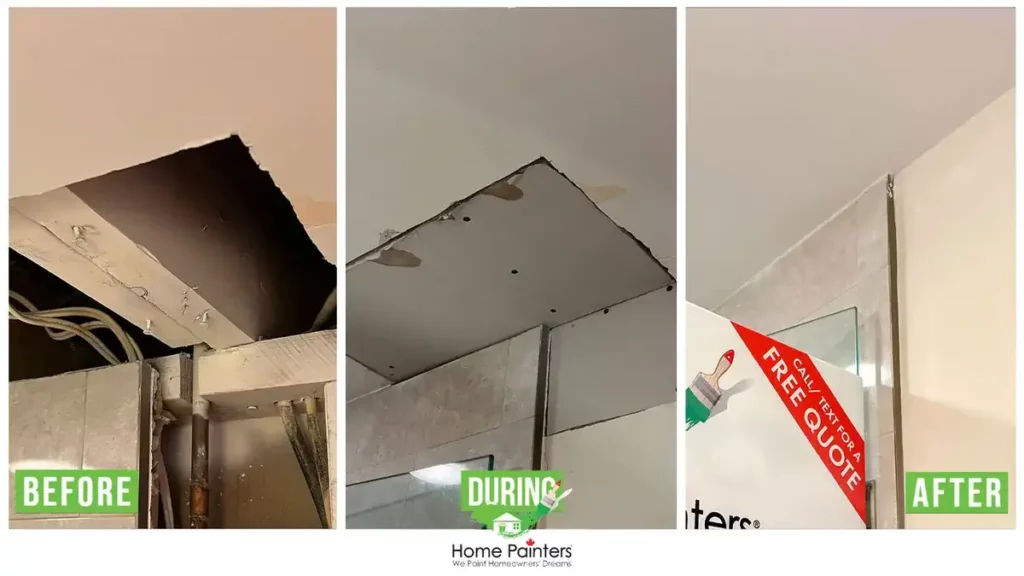Discover the Best Practices for Successful Drywall Repair Work and Setup
The art of drywall repair service and installment calls for a mix of ability and accuracy. Understanding the important tools is vital for accomplishing a seamless finish. Recognizing the step-by-step process can make a substantial difference in the final outcome. Proper techniques for taping and mudding are also essential. What continues to be is the expertise of maintenance that guarantees longevity. These elements together create a refined outcome worth exploring further.

Crucial Devices for Drywall Repair Work and Installation
When undertaking drywall repair service and installation, having the right devices can greatly improve the efficiency and high quality of the job. An energy blade is vital for reducing drywall sheets exactly, while a drywall saw can aid in making more elaborate cuts. Taping knives, offered in numerous sizes, are crucial for using joint compound smoothly and equally. A drywall sander, ideally with a dirt collection feature, aids accomplish a polished coating, decreasing the need for comprehensive cleaning.
Additionally, a gauging tape guarantees precise dimensions, and a level guarantees that installations are straight and plumb. Security gear, including dust masks and safety glasses, should not be overlooked to protect against particles and dirt. A stud finder aids in finding mounting members, ensuring protected setup. By outfitting oneself with these essential devices, the repair and installment process becomes more manageable and leads to a professional-quality end result.

Step-by-Step Overview to Patching Holes
Covering openings in drywall requires an organized method to guarantee a seamless repair. First, the location around the hole should be cleaned and any loosened particles removed. For small openings, a putty knife can be used to apply a lightweight spackle, pushing it into the opening and smoothing the surface. After it dries, sanding is crucial to produce a level surface. For bigger holes, a spot of drywall might be required. This entails cutting a piece of drywall a little bigger than the opening, securing it to the wall surface with screws, and making use of joint substance to cover the seams. As soon as the compound dries out, it needs to be sanded smooth. Keying the patched location before painting will certainly assure an even finish. Following these actions will result in a professional-looking fixing that mixes flawlessly with the surrounding wall surface.
Methods for Smooth Drywall Installment
Attaining smooth drywall installation needs careful planning and execution. Initially, it is vital to reduce and gauge drywall sheets accurately to minimize voids. Using an energy blade, installers need to rack up the board before snapping it along the cut line, guaranteeing clean edges. Appropriately straightening the sheets is vital; beginning with the leading and functioning down helps keep harmony.
Attaching drywall to the studs calls for consistent spacing, usually every 16 inches, making use of screws instead of nails for much better hold. This technique lowers the threat of pops over time. In addition, startling the joints between sheets boosts architectural stability and decreases the visibility of joints.
Using the appropriate density of drywall for details locations-- such as moisture-resistant types in bathrooms-- more adds to a perfect finish. Adhering to these methods will lead to a smooth and professional-looking installation, establishing the stage for the succeeding completing processes.
Ending Up Touches: Insulation and Mudding
Ending up touches, such as taping and mudding, play a crucial duty in accomplishing a polished drywall surface. Insulation entails applying a slim strip of drywall tape over the joints and seams, making sure a seamless appearance. This procedure assists avoid splits and produces a strong bond between drywall sheets. It is important to select the best kind of tape, with paper and fiberglass fit together being one of the most typical alternatives.
Mudding, or applying joint substance, follows insulation. This substance fills up in gaps and ravel the surface for a consistent finish. It is generally used in multiple layers, with each coat requiring to completely dry prior to sanding. Appropriate strategy involves feathering the sides to mix the substance right into the surrounding drywall, decreasing presence.
When finished appropriately, mudding and taping improve both the architectural and visual integrity of the drywall installation, causing a professional-quality surface.
Tips for Keeping Your Drywall After Setup

In addition, maintaining a constant interior humidity degree can stop warping or mold development. Utilizing a dehumidifier in wet areas, like cellars, is a good idea. It's additionally advantageous to regularly paint areas that show wear, as this shields the underlying material. When relocating furnishings or installing fixtures, care should be exercised to prevent harming the drywall. By adhering to these maintenance ideas, homeowners can prolong the life of their drywall, safeguarding it remains an eye-catching feature of their interiors.
Often Asked Inquiries
What Safety Gear Is Required for Drywall Repair and Setup?
For drywall fixing and installment, necessary safety and security equipment consists of safety goggles to protect eyes, dust masks to avoid inhalation of bits, handwear covers for hand security, and knee pads for convenience throughout long term kneeling. drywall contractors.
How Do I Establish the Drywall Density Needed for My Task?
To determine the drywall thickness needed for a project, one should take into consideration the wall surface's architectural demands, regional building ordinance, and the meant use the space, generally choosing 5/8-inch or 1/2-inch drywall.
Can I Repair Drywall Without Removing Furniture From the Room?
Yes, drywall can be repaired without removing furniture from the area. Mindful preparation and protective measures can minimize mess, permitting efficient repair services while keeping surrounding things risk-free from dust and damages throughout the process.
What Types of Drywall Are Finest for Various Atmospheres?
Moisture-resistant drywall is perfect for bathrooms and cooking areas, while soundproof drywall suits shared wall surfaces in homes. Fire-rated drywall is best for garages, and common drywall functions well generally living areas, making certain durability and viability for different atmospheres.
Exactly how Lengthy Does It Consider Drywall Mud to Dry Completely?
Drywall mud typically takes 24 to two days to dry entirely, depending upon variables like humidity and temperature (Interior Painting). Thicker applications may call for longer drying times, while thinner layers can dry out faster. Appropriate air flow aids drying out
The art of drywall repair work and installation needs a mix of skill and accuracy. When carrying out drywall drywall contractors repair and installment, having the right tools can substantially enhance the effectiveness and top quality of the work. An utility blade is important for cutting drywall sheets specifically, while a drywall saw can aid in making more elaborate cuts. Attaining smooth drywall installation demands cautious preparation and execution. Moisture-resistant drywall is optimal for kitchens and restrooms, while soundproof drywall fits shared wall surfaces in homes.